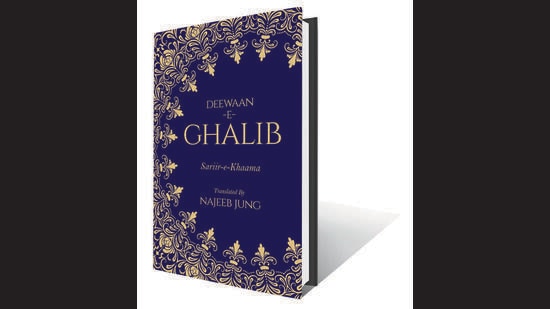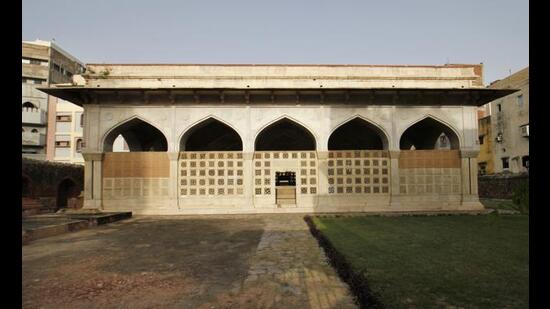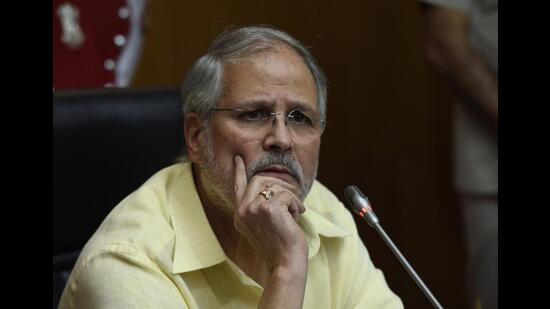Review: Deewan-e-Ghalib – Sariir-e-Khaama translated by Najeeb Jung
Though many have translated some of Ghalib into English, Najeeb Jung is the first to undertake the Herculean task of translating the poet’s entire output
It is perhaps not an exaggeration to say that Mirza Ghalib remains the most well-known poet in India. Shallow rhymes falsely attributed to him evoke immediate reverence, and a poetically-inclined young man is still hailed as a budding Ghalib in many parts of the subcontinent. Quoted in Parliament, in comedy shows, in spoofs, it is likely that his would be the first name to come up if the unpoetically-inclined were asked to name a poet. However, Ghalib was only one of a constellation of glittering contemporaries such as Momin, Nasikh, Atish and Zauq, who all wrote like him ie in the same vein as he did. Yet, outside Urdu circles, and often even within, lasting fame seems to have only been bestowed on Ghalib so that he has become not just the Urdu poet, but the Indian poet par excellence. This is not bad for someone who regarded himself primarily as a Persian poet and not an Urdu one.

Down the years, there have been valiant efforts to translate Ghalib into English. At the height of the cultural revolution of the 1960s, the late Aijaz Ahmad put together a collaborative effort with such renowned American poets as Adrienne Rich, Robert Bly and William Stafford, a book that he later came to disown! Frances Pritchett, the Columbia-based Urdu Professor and scholar extraordinaire has been toiling at Ghalib for decades, but nobody has attempted the translation of the entire deewan ie the entire official approved output of Ghalib until now. Najeeb Jung is the first one who has undertaken this Herculean task and he and his publishers Rekhta must be commended for their ambition. They must also be admired for the scrupulousness with which they have attempted the task, because the truth is that Ghalib is almost untranslatable.

Ghalib’s untranslatability is not his alone. Classical Urdu poetry is a poetry of convention, that is to say the themes it addresses, its ostensible topics, build upon metaphors such as the lamp, nightingale, hunting, cruelty, lamentation, helplessness etc. As the tradition developed, poets went on to make metaphors upon metaphors in an almost psychedelic loop. Like classical music, it is a poetry that demands intellectual decoding and therefore an initiation into the convention. The most popular of its genres, the ghazal, is a disparate collection of couplets, with no ostensible unity of thought except the metre, which is tightly observed. The couplets work in the thought — response, assertion; basis, claim; counterclaim, wonderment — ambiguity mode and thus often pack in an abundance of ideas. Like European metaphysical poetry of the 18th century, the theme is often cerebral, or conceited, or so full of artifice that an outsider is unable to penetrate the layers sufficiently. Take the first line of Ghalib’s deewan —
Naqsh Fariyadi Hai Kis Ki Shokhi e Tehreer Ka
A question is asked here, but a situation is also described. Somebody, not the poet necessarily, wonders, questions, in Najeeb Jung’s felicitous rendering —
Against whose playful writings can an image petition
We have thus far been given no information about who is speaking, where, for what, and have to wait for the second hemistich, which concludes the argument by stating that,
Kaghazi Hai pairahan har paikar e tasvir Ka
For made of paper is the attire of each image
It is not enough here to know the meaning of the words because the words are signifiers of something else. This is a lamentation about an unfathomable world, where our complaints, like marks on paper, are as flimsy as ourselves who are paper-like, or wearing paper in the mode of petitioners in pre-modern Persia, therefore all will dissolve, perhaps into nothingness.
The late great SR Faruqi (whose ideas form the basis of this review) used to tirelessly point out that like classical Sanskrit poetry, the ghazal is a poem about love, not a love-poem. That means it deals as much with transactions of love as with feelings of love. For love to be love here, it has to be unrequited and the beloved is always cruel; she/he is always out to hunt, maim, torture the lover, the protagonist of the poem, not necessarily the poet; in fact, mostly not the poet. This tradition glorifies suffering and sometimes so wittily exaggerates it as to become self-mocking. Suffering expands the heart, sometimes the piercing arrow of the beloved’s eyelash does that literally, and thus makes it a receptacle to receive, following the Sufis, divine love. Therefore, abasement, humiliation, sadism, flagellation, intense grief and public mourning are boons for the seeker who is sometimes also a saadhak,
Ishrate qatra hai dariya mein fana ho jana
Dard ka had se guzarna hai Dawa ho jana
Its ecstasy for a drop to annihilate itself into the sea
Pain beyond a limit becomes its own remedy
Since the lover is an outcast, a rebel he/she also becomes an iconoclast who pillories traditional figures of authority such as the preacher, the reformer and conventional social wisdom. Hence drinking, idols, rebellion, breaking of taboos is celebrated. Following its own Indo-Persian roots much Urdu poetry questions authority, conventional religiosity, social mores, the accepted realities, and can therefore be called subversive. But this is a literary convention, not necessarily a social attitude. However, this literary culture does partake of the Republican Religiosity that characterizes pre-modern Indian where dogmatic hegemony was not easily achieved.
But if these are traits of the poetic universe at large then why has Ghalib been singled out by posterity? Why did a celebrated early 20th century exegesis by Abdur Rahman Bijnori begin with this startling claim—
“India has produced only two revealed books. One is the Holy Vedas, the other is the Deewan-e Ghalib.”
One answer lies in Ghalib’s poetry, the other in his personality, perhaps, which influenced his reception. Alone among his contemporaries, Ghalib who had travelled to Calcutta and Benaras, was acutely cognisant of the tectonic shift the British progress had wrought on the world. He rebuked Sir Syed Ahmad Khan when the latter asked him to write an introduction to one of his Mughal histories, by stating that forget about the past and see what progress the Angrez have made. The world as he knew it was coming asunder and old certainties were dissolving. In his writings therefore, Ghalib began to subvert the conventional subversion. Ambiguity and scepticism became the hallmark of his canon, where his metaphysical speculations often faced an unresponsive and incomprehensible universe. We are all trapped here, not unlike Estragon or Vladimir, and there is no justice,
Kya Tang Ham Sitamzadgan Ka Jahan Hai
Jis Mein Ek Baiza e Moor Aasman Hai
How cramped is this world for us oppressed people
Where the sky seems but an egg of an ant
Nor can prayer or lament or worship or faith rescue you,
Mitta hai Faut e Fursat e Hasti Ka Gham Koi
Umr e Azeez Sarf e Ibadat Hi Kyun Na Ho
The sorrow of the demise of the reprieve of existence is never erased
Even if this precious life is all spent in prayer

In one of the great ironies of modern Urdu literature, Ghalib’s first biographer, and probably still the best one, Maulana Altaf Husain Hali, was also a great reformer. Following Sir Syed Ahmed Khan and other contemporaries such as Mohammed Husain Azad and Deputy Nazir Ahmed, he laid down a clear reformist agenda. Muslims had an inordinate role in the uprising of 1857 and had thus suffered disproportionate retribution, including the loss of political power. The uprising of 1857 and its brutal suppression marked the end of all possibilities of an indigenous revival. In response, the reformers came down heavily on North Indian Indo-Muslim custom, culture and literature. They dismissed all classical literature, especially ghazal. In one of the most chilling moments in world literature, a character in a Deputy Nazir Ahmed novel burns down his entire library consisting of such greats as Sadi, Hafiz, Mir etc in disgust because he finds them vulgar and reprobate. In his great reformist poem Hali went so far as to say,
Ye Sher o Qasaid Ka napak Daftar
Afoonat Mein Sandas Hai jis se behtar
This unholy collection of verses and odes
Stinks worse than a toilet
These reformers extolled sincerity, and nature and naturalness, and therefore their literary reform movement itself came to be called Naturi, ie Natural. These modernisers wanted Urdu poets to cease writing about the imaginary nightingales and beloveds and gardens and instead, urged them to compose simple, direct, spontaneous poetry and to write about real forests and trees, a la Wordsworth or Keats. The self-hatred borne of this made Hali and Azad dismiss most of the previous poetic heritage. They urged a wholesale purge of the literary heritage but Hali concluded that Ghalib was one poet who could be placed alongside European greats. Hali’s biography thus tried to present Ghalib as the archetypal poet — haughty, witty and exclusive. However, Ghalib’s cerebral style, known within the tradition as Khyalband, literally to weave thoughts, was a feature common to his contemporaries such as Nasikh and Momin. The others were given short shrift, but in the case of Ghalib Hali tried to show how his poetry and his personality were in accord, a demand never made of classical poetry. Thereafter, Ghalib was, so to say, plucked out of the canon and presented as a sui generis poet who could be read alongside world greats such as Shakespeare or Goethe. No insider specialized knowledge was therefore, and thereafter, required to read Ghalib. This is not to say that Ghalib is not unique. He indeed is, and his oeuvre contains a remarkable juxtaposition of the highly abstruse with the highly affective such as
Aah Ka Kisne Asar Dekha Hai
Ham bhi Ek Apni Hawa Bandhte Hain
Who has ever seen a sigh bear fruit
All we do is draw a breath and say Ah
Acutely sensitive to changes wrought by print culture and by the new literary values introduced by the colonial masters, Ghalib was also the first to be very selective about his deewan. Unlike his predecessors, he cast a very discriminating and exacting eye over what was to be published and, as Mehr Afshan Faruqi has shown in her wonderful new biography, was therefore quite modern in his concern with brevity and with his poetic image before posterity. Although the world of the ghazal is a synchronic one, in the sense that the era of Mir’s poetic universe and ours is the same, Ghalib was still unique. He was both the last of our classical poets and the first of our moderns and he felt the existential burden and cultural crisis that was to define us in his life and ours. Irony rules strong and long in his works, an emotion that speaks immediately to our desperate lives. You may try to seek solace in devotion but it is ineffectual,
Kya vo Namrud Ki Khudai Thi
Bandagi Mein Mera Bhala na hua
Was that Godhood Nimrod’s or What
Submission brought me no profit whatsoever
Among his contemporaries Ghalib felt this crisis of the loss of old certainties most acutely and expressed that loss of faith, the denouement of a vanishing world plaintively. This scepticism, this agnosticism, this ambiguity resonates with our Godless era —
Hain Zawal Aamada Ajza Aafreenash Ke Tamam
Meher e Gardoon Hain CHiragh e Rahguzar e Baad Yaan
All configurations are destined to end with time
The sun is like a lamp in the path of a tempest
In this stark universe, love, the acme of human emotion and the most prized possession for the protagonist of the ghazal ie requited love is not good enough,
Teri Wafa se Kya Ho Talafi ki Dahar Mein
Tere siva bhi ham pe bahut se sitam huwe
What amends can there be from your faithfulness in the world
Apart from you there have been other cruelties as well

But even poetry or words themselves are not enough, not enough consolation, and also not enough to express the existential anguish, the angst. After all, words are used to represent reality; they can only gesture, not fully apprehend reality, which is inescapable grief. It is important to point out, once again, that while Ghalib is the one penning these verses, they are not necessarily his emotions. We know that the historical Ghalib was a witty, cheerful, gregarious man who loved his wine and mangoes and friends and compulsively conducted a bountiful correspondence and wrote beautiful letters. He had his share of sorrows — financial hardship, the lack of progeny, the depredations of 1857 — but, by all accounts, he was not a tortured soul. Yet, he produced outstanding verses about sorrow, about the meaning or lack of meaning of life and suffering. For instance, imagine the pain, the anguish of the person who in his craziness whiled his time away by repeatedly hitting his forehead. And now his hand is broken. What is he to do now? How will he pass his time, his life? You may be left bereft even in madness,
Bekari e Junoon ko tha sar peetne ka shagal
Jab hath toot jaayein to phir kya kare koi
The desolation of madness found occupation in self flagellation
But what is one to do when the limb itself lies broken
The starkness must be faced even when it cannot be faced. It might help to laugh at yourself that even as you chase the wilderness, the wilderness eludes you
Har qadam doori e manzil hai numayan mujh se
Meri Raftar se bhage hain Bayaban mujh se
Each step of mine reveals how far I am from the destination
My very speed makes the wilderness run faster away from me

But in the end truth, like beauty, is laid to waste because the world is not a place where you can find salvation or even appreciation for the world is not what it appears to be,
Hain Ghaib e Ghaib Jis Ko Samajhte Hain Ham Shahood
Hain Khvab Mein Hanuz Jo Jaage Hain Khwab Mein
Its divinely concealed what we believe is manifest
They are in a dream those who think they are awake
Najeeb Jung, who was taught Ghalib by his mother, and who, as a child, recited Ghalib to Maulana Azad has redeemed his mother’s enormous debt by presenting a work that makes Ghalib immediately and simply accessible to all of us. The book is also studded with some stunning calligraphy. It is a laudable effort but while the translations are sometimes felicitous and occasionally mellifluous, many verses demand more than paraphrasing. On the other hand, if one started giving notes and explanations for every hidden pun and alliteration and concealed thought in every couplet, then one may require a book for each ghazal. Najeeb Jung’s achievement is even more remarkable when we remember the poet’s boast about the inaccessibility of his verses —
Aagahi Daam-e shuneedan jis qadar chahe bichhaye
Mudda’a anqa hai meri aalam e tehreer ka
No matter how wide apprehension spreads its web
The point of my utterance will escape it like the unsighted Anqa bird
Mahmood Farooqui is a Delhi based writer best known for reviving Dastangoi. His latest work is the Dastan-e Raza on the life and times of Syed Haider Raza, one of India’s greatest modern painters.





